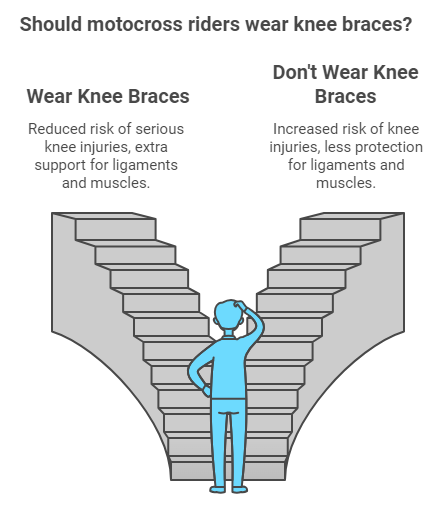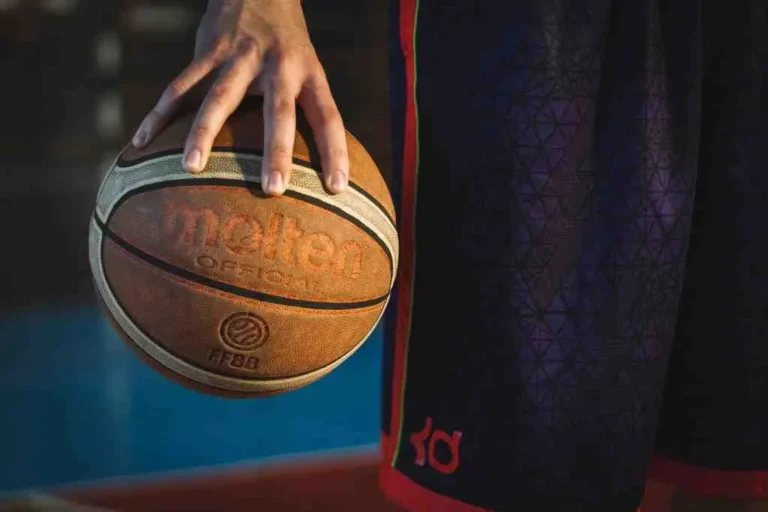Do Motocross Knee Braces Work? Exploring Their Effectiveness
It is no secret that motocross is rough on the knees, and you can easily get injured. Many riders have experienced that sudden, painful twist. A motocross knee brace offers the support you need to keep your knees safe while riding. We will explore how these braces work, in a way that is easy to understand. I will share simple facts to show you why they are worth considering. Let’s see if you can benefit from a motocross knee brace.

Effectiveness of Motocross Knee Braces
Reduced Risk of Knee Injuries
Motocross knee braces play a vital role in reducing the risk of knee injuries by providing stability to your joints during extreme riding. The knee joint is highly sensitive to injuries like ligament tears, sprains, and hyperextension due to the continuous twists, turns, and high impact of motocross riding. These braces function as an external support system by limiting undue movement and absorbing shocks, which helps prevent sudden twists or bends that can cause serious injuries. This extra layer of protection ensures that even when you take a hard fall, your knee has a better chance of bypassing the damage.
According to MDPI: Musculoskeletal injuries are common in motocross, with nearly half (42%) of all ligament injuries affecting the knee ligaments.

Importance of Wearing Motocross Knee Braces
Prevention of Serious Injuries
Wearing a motocross knee brace can help keep you from getting seriously hurt while riding. The brace acts like a shield around your knee, stopping it from bending or twisting too much when you land from jumps or hit rough terrain. This means that even if you take a fall, the brace can reduce the impact on your knee and help protect it from serious damage.
By keeping your knee joint in the right position, the brace also takes some of the stress off your ligaments and muscles. This extra support is important because it lowers the chances of tearing a ligament or getting other major injuries. With a knee brace, you can push your limits while riding, knowing you have that added layer of protection to help keep you safe.

Maintenance of Agility and Confidence
Agility is key to riding the bike effectively. Motocross knee braces with straps allow riders to maintain their agility by providing support without restricting movement excessively. As a result, bike riders can confidently navigate tracks knowing that they have an extra level of protection for their knees.
Types of Motocross Knee Braces Explained
Hinged Knee Braces

Hinged knee braces are crucial for motocross riders as they offer maximum support and stability by replicating the natural movement of the knee joint. These braces help prevent hyperextension or twisting injuries during intense bike rides. For example, when landing a jump with significant force, hinged knee braces provide essential protection to avoid potential ligament damage.
Hinged Knee Braces:
Unloader/Offloader Knee Braces
Designed to alleviate pressure on specific areas of the knee affected by conditions like arthritis or meniscus tears, unloader/offloader knee braces are beneficial for motocross enthusiasts dealing with these issues. These braces redistribute weight within the knee joint, reducing pain and discomfort while riding challenging terrains.
Custom-Made vs. Standard Knee Braces for Riders
Tailored Support and Comfort
Custom-made knee braces are personalized to fit a rider’s leg shape, offering optimal support and comfort. These custom braces cater to individual needs, ensuring a snug fit that enhances performance.
Riders who prefer tailored solutions often opt for custom-made knee braces with a hinged frame. The design of these braces considers factors like size, hinge style, and closure mechanisms for a perfect fit.
Affordable Protection Options
On the other hand, standard motocross knee braces provide riders with affordable protection without customization features. These off-the-shelf options are suitable for those on a budget or riders who do not require specialized fittings. Standard knee braces come in various sizes, designs, and hinges to accommodate different preferences. While they may lack the tailored fit of custom-made options, they still offer essential support during rides.
Pros and Cons of Using Knee Braces
Benefits of Using Knee Braces
Motocross knee braces are essential for riders as they reduce the risk of knee injuries. These braces provide crucial support to the knees, enhancing stability during jumps and landings. By offering this added protection, knee braces can significantly boost a rider’s confidence on the track.
Knee braces also play a vital role in preventing many knee injuries that motocross riders are prone to. Braces help distribute forces evenly across the knees, reducing pressure points and minimizing the impact on long bones like the thigh bone. This balanced support, like a brace, helps in maintaining healthy knees over time and can even prevent the need for surgeries caused by severe injuries.
Drawbacks of Using Knee Braces
On the downside, some riders may find knee braces uncomfortable or restrictive during their rides. The straps and structure of certain knee brace models might limit a rider’s range of motion, affecting their performance on the track. Improper fitting or prolonged use can lead to skin irritation at pressure points where the brace comes into contact with the skin.
Knee Pads vs. Knee Braces in Motocross

Impact Protection and Support
Knee pads are ideal for minor impacts and abrasions, offering basic protection without substantial support to the knee joint. On the other hand, knee braces not only shield against impacts but also provide crucial stability to prevent severe injuries like hyperextension or ligament tears. For motocross riders facing demanding terrains and jumps, this added brace support can be a game-changer in injury prevention.
Knee pads and braces excel in less intense rides where impact protection is sufficient. However, for motocross riders navigating challenging tracks requiring enhanced stability, knee braces become essential gear. The significant difference lies in the level of support each provides: knee pads focus on cushioning from falls, while knee braces prioritize structural integrity to safeguard the knee joint during extreme movements.
Choosing the Right Gear
When considering between knee pads and knee braces for motocross activities, it’s vital to assess your riding style and terrain challenges. Opting for knee braces ensures comprehensive protection against potential ligament damage or hyperextension that could sideline you from future rides due to injury recovery time.
Evaluating Fit and Testing Knee Braces for Motocross
Importance of Proper Fit
Selecting the right knee brace is crucial in motocross to ensure optimal support and comfort while riding. An ill-fitting brace may not provide the necessary protection or could cause discomfort during rides. Riders must prioritize finding a knee brace that fits snugly without being too tight, allowing for freedom of movement.
Choosing a knee brace that matches your leg’s measurements is essential to prevent any sliding or shifting during motocross activities. Fit plays a significant role in how effective a knee brace will be at protecting against injuries while riding on challenging terrains.
Testing Mobility and Comfort
Before settling on a specific knee brace, riders should test them by simulating movements encountered during motocross rides. By trying out various braces through motions like bending, squatting, and jumping, riders can assess how well the braces allow for natural movement without restricting mobility or causing discomfort.
Consulting with healthcare professionals or experienced riders when evaluating different knee braces can offer valuable insights into which options are best suited for individual needs. Seeking guidance from those with experience can help in making informed decisions regarding fit, comfort, overall performance, and brace on the track.
Final Remarks
So, do motocross knee braces work? Absolutely. They are a game-changer for riders, offering crucial support and protection to your knees with a brace during those intense rides. From understanding the different types available to evaluating their fit and function, knee braces can make a significant difference in your performance and safety on the track. Whether you opt for custom-made or standard braces, ensuring you have the right support for your knees is key to staying on top of your game.
Now that you’re equipped with knowledge about motocross knee braces, it’s time to gear up and hit the track with confidence. Remember, safety always comes first in extreme sports like motocross. So, don’t forget to invest in quality knee braces and ride on knowing you’ve got the best protection for your knees!






